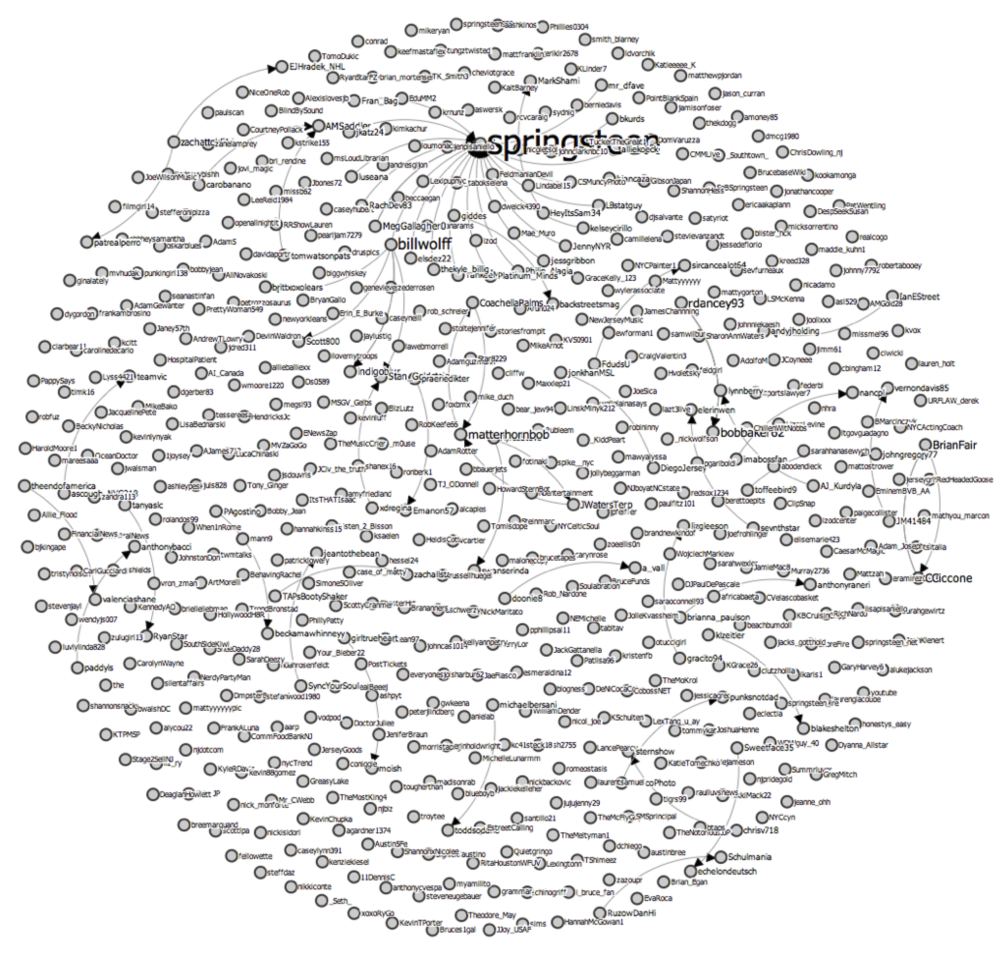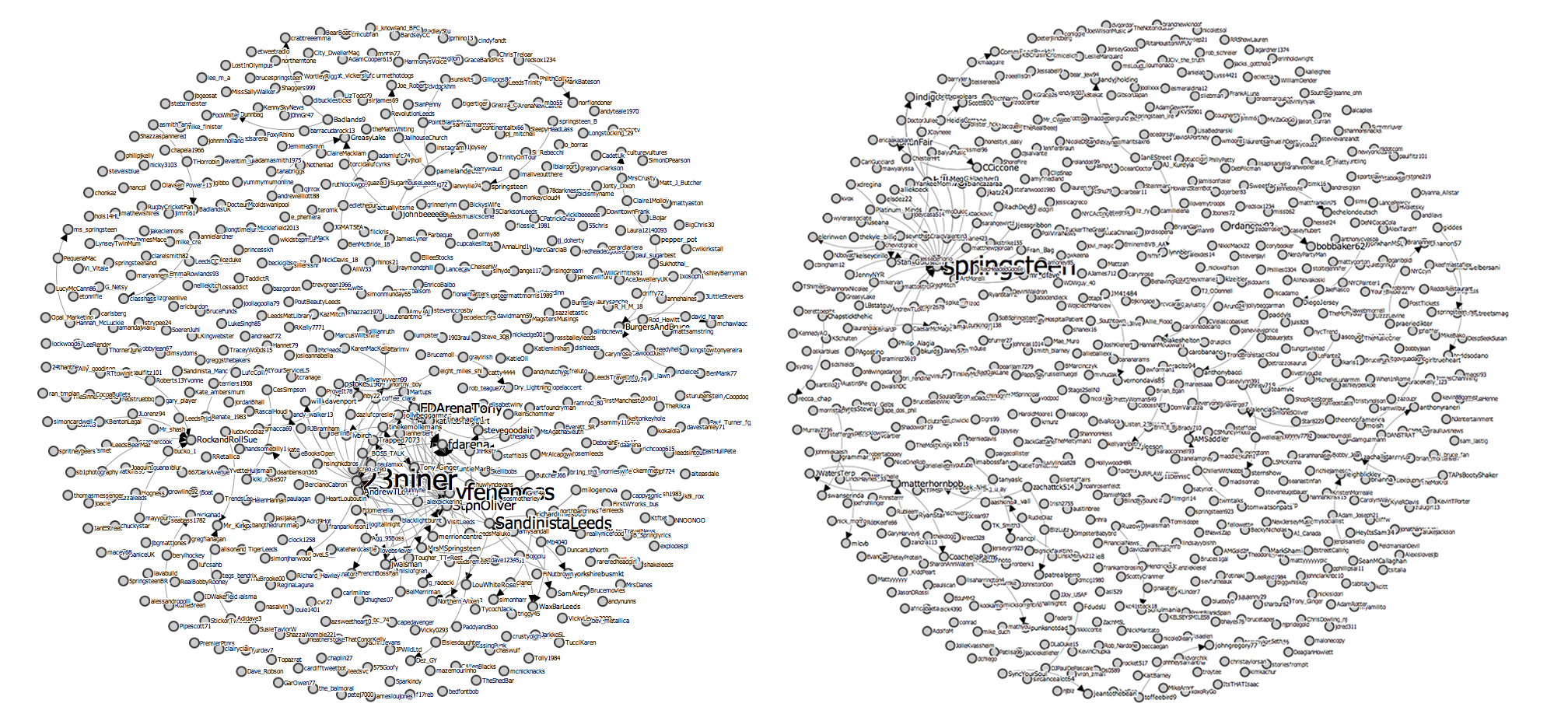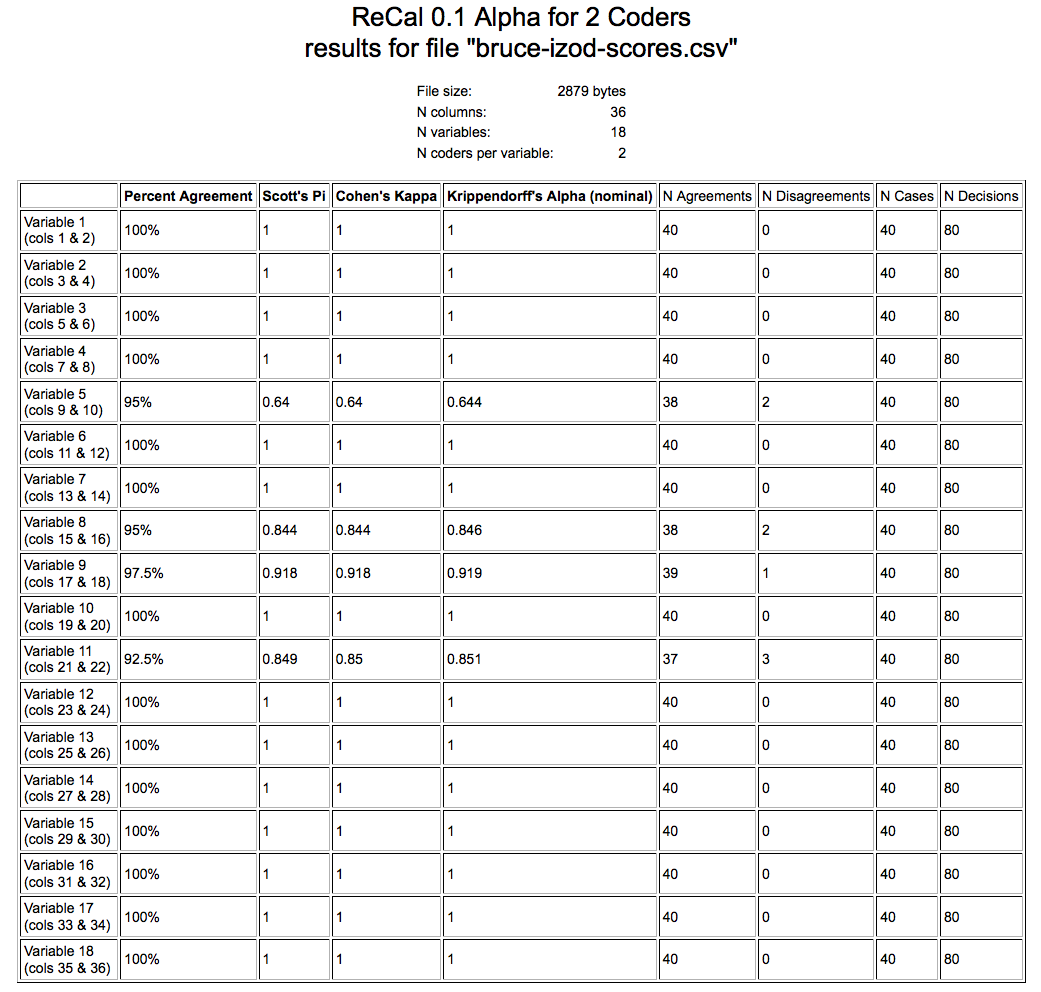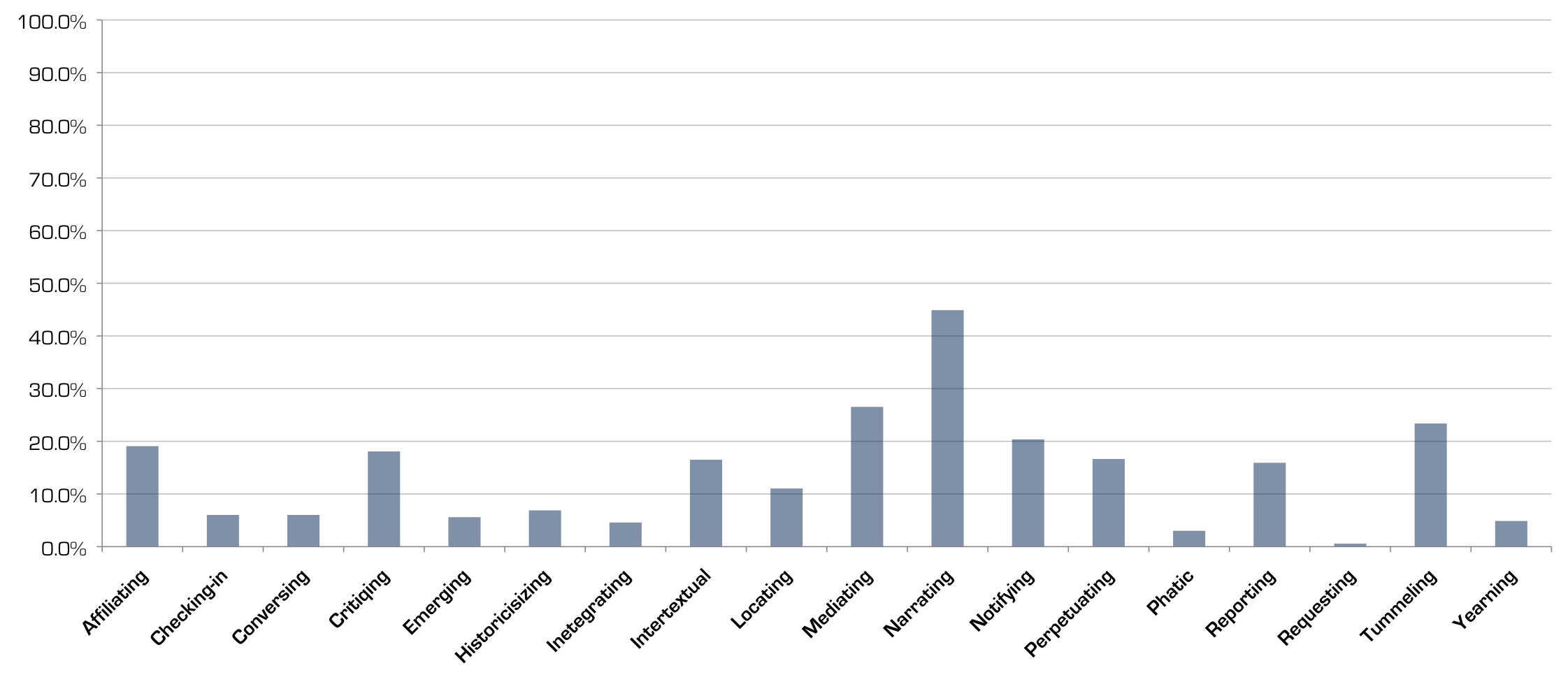

The April 4, 2012 concert at the Izod Center in East Rutherford, New Jersey places Bruce Springsteen and the E Street Band in their home state at the former Brendan Byrne Arena, which they opened in July 1981 with a six-concert run. The April 4 show was early in the tour, which in part accounts for a short set list of 24 total songs (the maximum for a single concert on the Wrecking Ball tour was 33) and a shorter duration of 2 hours 39 minutes (the longest of the tour was 4 hours 6 minutes in Helsinki, Finland, on July 31, 2012). With 19 musicians on stage, it was the largest E Street Band ever, including 4 back-up singers (The E Street Choir) and 5 horns players (The Street Horns). The horns section was created after the June 18, 2011 passing of legendary E Street Band saxophonist Clarence Clemons. Clemons's nephew, Jake Clemons, was a member of the horns section, using his uncle's saxophone.
In July 2012 I exported from my yourTwapperKeeper archive 14,156 tweets tweeted on April 4 and April 5, 2012 that contained the keyword Springsteen. It is important to note the archive was not just searching for the hashtag #Springsteen, but for all mentions of the keyword Springsteen. I decided to search for the keyword instead of the hashtag because a keyword search will find all instances of the hashtag. Doing so would also allow me to consider why some writers on Twitter are using the hashtag and why some are not. After importing the tweets into Microsoft Excel, adjusting tweet times from Greenwich Mean Time to Eastern Standard Time, and filtering the corpus to fit within the time constraints, 4,205 tweets remained. Of those tweets, 2,972 were about Bruce Springsteen (a significant number were about Eric Church’s song "Springsteen" which was rising up the charts in spring 2012). Of those, 697 tweets from 491 unique accounts were related to the April 4 concert at the Izod Center. The median number was 1 tweet per account.
A network visualization generated by Martin Hawksey's TAGSExplorer (2011) shows connections among accounts in the Izod show corpus. Arrows indicate the direction of @replies and @mentions. The visualization suggests few actual conversations among people tweeting about the concert. Though the @springsteen account did not tweet once about the concert, it was mentioned 131 times, resulting in its prominent size. We also see minor connections between other accounts, but nowhere near as many as we'd see if significant conversation was taking place. This visualization is representative of those created from corpuses based on keyword searches: many people, few actual connections.

The lack of conversations among fans in the Izod corpus is made apparent when juxtaposed against a TAGSExplorer visualization of a corpus containing tweets about Springsteen's July 24, 2013 concert in Leeds, England containing the #bruceleeds hashtag (Wolff, 2015):

The visualizations suggest authors in the #bruceleeds corpus were more engaged with one another, whereas the authors in the Izod corpus were more interested in writing about their own experiences without incorporating other fans.
The first stage in a grounded theory study is open coding. In open coding, researchers attempt to gather and categorize as much information as they can from their units of analysis. The process is exhaustive, noting even the smallest details. Two research assistants and I identified 48 categories, which are listed below in alphabetical order with brief definitions:
@
a tweet that contains an @reply or @mention
@sp
a tweet that contains @springsteen
#
a tweet that contains a hashtag
#Sp
a tweet that contains a #springsteen hashtag
85
a tweet mentioning or with lyrics from the song "1985" by Bowling for Soup
ALB
a tweet containing an albumin title
ANN
a tweet containing an announcement about Springsteen-related news
ANTI
a tweet that is anti-Springsteen
AppT
a tweet sent via an app, such as Foursquare
BL
a tweet with a broken link
COM
a tweet containing general commentary or review about Springsteen or his music that is not about a concert
CT
a tweet posted during a concert
DT
a duplicate tweet
EC
a tweet about the song "Springsteen" by Eric Church
ECLyr
a tweet containing lyrics to the song "Springsteen" by Eric Church
ESB
a tweet that mentions the E Street Band or any of its members individually
EX
a tweet that is part of an extended conversation which lasts more than two tweets
FL
a tweet in a language other than English
GEN
generic tweet informing people what they are
thinking, doing, or will do and falls into no other category
L2CP
a tweet containing a link to a concert photo
L2CV
a tweet containing a link to a concert video
L2P
a tweet containing a link to a photo
L2V
a tweet containing a link to a video
LINK
a tweet containing a URL to a web site
LREV
a tweet containing a link to a review of a concert
LTSP
a tweet where the author is listening to a Springsteen song
LYRIC
a tweet containing Springsteen song lyrics
Mu@
a tweet @replying or @mentioning more than one user
MURT
a tweet with more than one retweet
NEWS
a tweet about something Springsteen-related in the news
OCOM
a tweet that encourages online community engagement
OM
a tweet that mentions a musician other than Springsteen or Eric Church
OTC
a tweet about a concert that is not on the Wrecking Ball tour
OTG
a tweet that describes being on the go
OWBC
a tweet about a concert on the Wrecking Ball tour
other than the one for the corpus under study
POT
a tweet posted after the concert or about post-concert events
PT
a tweet posted before the concert or containing pre-concert activity
RAD
a tweet that mentions listening to the radio
REV
a tweet that is a concert review
RT
a retweet
SOC
a tweet that encourages local community engagement
SoT
a tweet that contains a Springsteen song title
SPAM
a spam tweet
SPG
a tweet mentioning Springsteen gear and clothing
SPRG
a tweet where Springsteen himself is mentioned
TC
a tweet that mentions ticket companies
TIX
a tweet about getting Springsteen concert tickets
WB
a tweet that mentions the Wrecking Ball album
From the 48 categories that emerged during open coding, I decided to focus on a group of tweets that contained content relating to pre-, during, and post-concert activities. These were chosen because the content was the most engaging and contained complex fan activities. Those tweets embodied many of the other categories, as well. As a result, many of the categories that emerged during open coding directly informed the creation of the more abstracted categories that emerged during axial coding.
For example, @ (a tweet replying to or mentioning another user) and @SP (a tweet mentioning the @springsteen account) directly informed the creation of Conversing and Notifying. Tweets that contained links to other media (categories: L2CP, L2CV, L2P, L2P, LINK, LREV, and others) informed the creation of Mediating. Tweets with lyrics (LYRIC), album titles (ALB), and/or song titles (SOT) informed the creation of Intertextual. Other categories listed below, such as Integrating and Historicizing, emerged after looking closer at the variety of activities labeled as being a "generic tweet informing people what they are thinking, doing, or will do and falls into no other category" (GEN). Indeed, that is the goal of axial coding: to see the data in new ways based on the focus of the inquiry.
To complete axial coding, I adopted Kathy Charmaz's (2006) approach of using gerunds when coding. Charmaz (2006) argued that "adopting gerunds fosters theoretical sensitivity because these words nudge us out of static topics and into enacted processes. Gerunds prompt thinking about actions—large and small" (p. 136). Whereas the categories that emerged from open coding were "static topics," most that emerged from axial coding are composed as gerunds. Those that could not be formed into gerunds still suggest, as Charmaz (2006) advocated, "emphasis on actions and processes" (p. 136).
An initial inter-rater reliability test of the 18 categories identified concerns with the definitions of integrating, intertextuality, narrating, and perpetuating. Definitions were revised and a second inter-rater reliability test found significant agreement between raters:

I have presented below each of the 18 categories, along with the percentage of total tweets, definitions, and example tweets. I've highlighted and underlined the part of the tweet that resulted in the code being applied to it. Tweets could be assigned more than one code. All spellings and punctuation are original to the tweets. Those discussed in more detail are linked to their extended discussion.
A tweet that includes a Springsteen-related hashtag (not the use of @springsteen). Not counted when in a tweet that was retweeted unless the hashtag was added to a modified retweet.
Example Corpus Tweet
Just back from the #springsteen concert with my brother in jersey. 3 hours of incredible. The boss is simply the best there is.
A tweet tweeted via a checking-in app like FourSquare.
Example Corpus Tweet
BRUUUUUUCE (@ IZOD Center for Bruce Springsteen & The E Street Band w/ 88 others) http://t.co/8rgpR0Xp
A conversation between two or among more than two users. Distinct from tummeling.
Example Corpus Tweet
@patrealperro @yankeemom7 Oh yea - The Ties that Bind too! Check out the whole setlist on http://t.co/6iq4XdPb
A tweet with a value judgment.
Example Corpus Tweet
Um. Best concert ever or best concert ever? #bruuuuce @springsteen
A tweet directly in response to something happening at the concert, which contains what might be described as "a spontaneous overflow of powerful emotion."
Example Corpus Tweet
Touched @springsteen 3 fucking times with @AJames712 and @Mattyyyyyy!!!!!!
A tweet in which the author locates their activities within a history of their own life.
Example Corpus Tweet
It took me 20+shows and being a fan since birth 26 yrs ago but I finally got my favorite live Racing in the Street #springsteen #happytears
A tweet that integrates the language or actions of the Springsteen fan discourse community.
Example Corpus Tweet
Bruce Springsteen tonight at the Izod Center......bruuuuuuucccceee!
A tweet that overtly or unconsciously has its full meaning in the understanding of a larger context.
Example Corpus Tweet
Ties That Bind! Jackson Cage! Johnny 99! Racing in the Street! Trapped! Thanks, @Springsteen & E St Band for scorching show. See ya Friday!
A tweet where the author locates oneself in a particular tour city or city space, such as a pit queue roll call location, city landmark, local business, and so on.
Example Corpus Tweet
In Jersey. At a #Springsteen concert. Life doesn't get TOO much better.
A tweet that links to an image, video, or other external media.
Example Corpus Tweet
Bruce Springsteen tonight at Izod singing "Promised Land." http://t.co/BCcpT253
A tweet describing or depicting one’s own events at a concert. These tweets can be days in advance or days after, as the experience of the concert tends to begins long in advance and continue for some time after.
Example Corpus Tweet
Bruce Springsteen is sweaty to the touch #Itouchedhim #letmedie
A tweet using an @mention not necessarily to have a conversation but to alert someone that they have been mentioned.
Example Corpus Tweet
If blowing all my money on seeing bruce @springsteen is wrong, i dont want to be right. #izod
A tweet perpetuating the larger narrative of epic Springsteen shows: rare songs, being brought on stage, tour premiers, and so on.
Example Corpus Tweet
yup, he chugged a dude's beer then crowd surfed back to the stage. #springsteen
A tweet that doesn't contain significant additional information to place it in another code (McNely 2010, p. 4).
Example Corpus Tweet
You shouldn't be holding spots against the barricade, people. Especially if you're bringing back smelly hot dogs. #Springsteen
A tweet that informs others of events or news relating to the concert itself. Many of these are tweeted from news organizations, blogs, or individuals linking to them.
Example Corpus Tweet
"We opened this place 30 yrs ago when it was named after a person. Now it's named after a shirt."-Springsteen @ Izod Ctr
A tweet to the general Springsteen community asking a question, requesting information, and so on.
Example Corpus Tweet
Anybody going to the show and travelling on rt 46? #Springsteen
A tweet that "facilitat[es] conversation and engagement within online communities" (McNely 2010, p. 4). Here, retweets.
Example Corpus Tweet
RT @backstreetsmag: E Rutherford Night 2 report up now, @AMSadler photos to come http://t.co/cpRtYiJz #springsteen #WBNJ2
A tweet that expresses a desire to have been at the show.
Example Corpus Tweet
I can't even describe how jealous I am of all the people at the #Springsteen concert tonight #Trapped and #CandysRoom #cantaskformore
A graph of category percentages reinforces much of what we see in the TAGSExplorer visualization of the Izod show: significant narrating of events, little conversing, some notifying of others, and lots of retweeting.

However, the analysis also revealed more nuanced composing practices: fans Historicizing (6.9%) their concert experiences; making many Intertextual (16.5%) references; and Perpetuating (16.6%) the legendary events that take place at Springsteen shows. All three were seen in higher percentages than the number of tweets that showed Conversing. We also see fans Integrating (4.7%) the language and actions of the discourse community and Mediating (26.5%) their experiences with Twitpics, Instagrams, Checking-in links, videos, and links to set lists and concert reviews. Fan are also making connections to being at the Izod Center in New Jersey by locating (16.6%) their tweets within the specific spaces they are in.
Breaking the categories into pre-, during, and post-concert tweets reveals more nuances in the data.

Affiliating (using a Springsteen-related hashtag) remained consistent throughout, but checking-in vanished by the time the concert was over. Indeed, by then there was no need to check in. Fans had arrived, saw the concert, and were leaving. Critiquing, however, showed drastic increases during the concert and after, as fans reflected on the show, tweeting about how amazing and memorable the show was, that it was one of the best ever. Reporting also showed drastic increases as fans tweeted reviews of and videos from the concert.
What are you doing?
After reading a draft of "Baby, We Were Born to Tweet," Girltrueheart (2014) reminded me that data reception was quite poor at the Izod Center, which could account for why there were fewer Mediating tweets sent during the concert. Indeed, after reading Girltrueheart's (2014) email, I remembered this tweet from the corpus: "Cell service extremely spotty at #Springsteen" (personal communication, March 9, 2014).
Intertextual and Mediating are almost the inverse of one another, which is interesting. An intertextual tweet "overtly or unconsciously has its full meaning in the understanding of a larger context." Mediated tweets after the show include many Twitpics and Instagrams of photos captured during the show but not tweeted—no time to tweet such things while screaming one's head off as Springsteen crowd surfs, chugs a fan's beer, dances with someone on stage, and plays nonstop for what is described as three hours (but wasn't really). Instead you tweet these things after the show, which perpetuates the legend that is a Springsteen concert.
Of the 18 Categories, I'm most interested in discussing the following five in greater detail:
These five were organized within a larger category, Practicing, which emerged during selective coding. I borrow the term practicing from Etienne Wenger's (1998) usage in Communities of Practice: Learning, Meaning, and Identity and Henry Jenkins's (2013) assertion that "fandom involves a particular set of critical and interpretive practices" (p. 278). Wenger's (1998) understanding of practice is pertinent here because he situated it within communities and their participatory actions and texts. Jenkins's (2013) description is important because he located it within "the community’s preferred set of reading practices" (p. 278). Wenger (1998) defined participation in terms of community membership: it "is both personal and social. It is a complex process that combines doing, talking, thinking, feeling, and belonging. It involves our whole person, including our bodies, minds, emotions, and social relations" (pp. 55–56). Participation, for Wenger, is social, which is informed by the social characteristics of practice. Practice
includes both the explicit and the tacit. It includes what is said and what is left unsaid. It includes language, tools, documents, images, symbols, well-defined roles, specified criteria, codified procedures. . . . But it also includes all the implicit relations, tacit conventions, subtle cues, untold rules of thumb, recognizable intuitions, specific perceptions, well-tuned sensitivities, embodied understandings, underlying assumptions, and shared world views. (Wenger, 1998, p. 47)
Each of these categories suggests the author exists within a larger community that has adopted the community’s reading and composing practices.
Track 4: Background and Methodology
Track 6: Historicizing